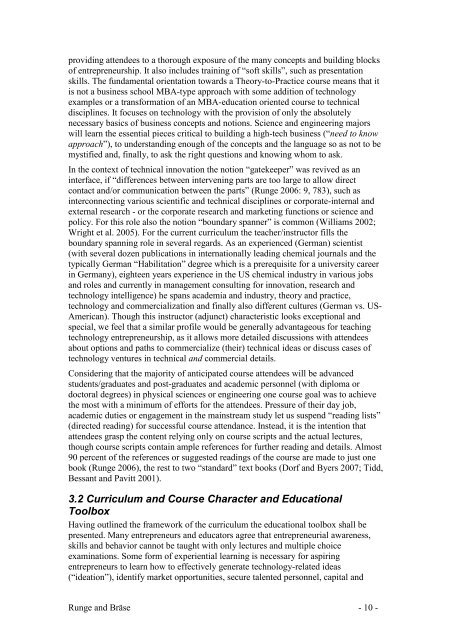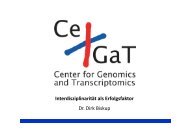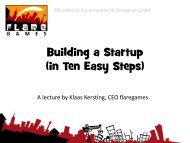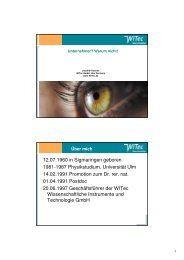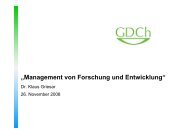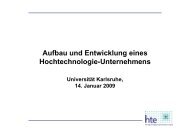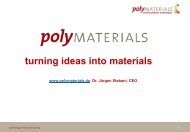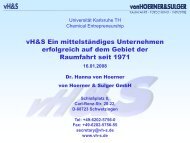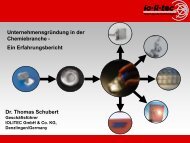Education in Chemical Entrepreneurship - KIT - Technology ...
Education in Chemical Entrepreneurship - KIT - Technology ...
Education in Chemical Entrepreneurship - KIT - Technology ...
Create successful ePaper yourself
Turn your PDF publications into a flip-book with our unique Google optimized e-Paper software.
provid<strong>in</strong>g attendees to a thorough exposure of the many concepts and build<strong>in</strong>g blocks<br />
of entrepreneurship. It also <strong>in</strong>cludes tra<strong>in</strong><strong>in</strong>g of “soft skills”, such as presentation<br />
skills. The fundamental orientation towards a Theory-to-Practice course means that it<br />
is not a bus<strong>in</strong>ess school MBA-type approach with some addition of technology<br />
examples or a transformation of an MBA-education oriented course to technical<br />
discipl<strong>in</strong>es. It focuses on technology with the provision of only the absolutely<br />
necessary basics of bus<strong>in</strong>ess concepts and notions. Science and eng<strong>in</strong>eer<strong>in</strong>g majors<br />
will learn the essential pieces critical to build<strong>in</strong>g a high-tech bus<strong>in</strong>ess (“need to know<br />
approach”), to understand<strong>in</strong>g enough of the concepts and the language so as not to be<br />
mystified and, f<strong>in</strong>ally, to ask the right questions and know<strong>in</strong>g whom to ask.<br />
In the context of technical <strong>in</strong>novation the notion “gatekeeper” was revived as an<br />
<strong>in</strong>terface, if “differences between <strong>in</strong>terven<strong>in</strong>g parts are too large to allow direct<br />
contact and/or communication between the parts” (Runge 2006: 9, 783), such as<br />
<strong>in</strong>terconnect<strong>in</strong>g various scientific and technical discipl<strong>in</strong>es or corporate-<strong>in</strong>ternal and<br />
external research - or the corporate research and market<strong>in</strong>g functions or science and<br />
policy. For this role also the notion “boundary spanner” is common (Williams 2002;<br />
Wright et al. 2005). For the current curriculum the teacher/<strong>in</strong>structor fills the<br />
boundary spann<strong>in</strong>g role <strong>in</strong> several regards. As an experienced (German) scientist<br />
(with several dozen publications <strong>in</strong> <strong>in</strong>ternationally lead<strong>in</strong>g chemical journals and the<br />
typically German “Habilitation” degree which is a prerequisite for a university career<br />
<strong>in</strong> Germany), eighteen years experience <strong>in</strong> the US chemical <strong>in</strong>dustry <strong>in</strong> various jobs<br />
and roles and currently <strong>in</strong> management consult<strong>in</strong>g for <strong>in</strong>novation, research and<br />
technology <strong>in</strong>telligence) he spans academia and <strong>in</strong>dustry, theory and practice,<br />
technology and commercialization and f<strong>in</strong>ally also different cultures (German vs. US-<br />
American). Though this <strong>in</strong>structor (adjunct) characteristic looks exceptional and<br />
special, we feel that a similar profile would be generally advantageous for teach<strong>in</strong>g<br />
technology entrepreneurship, as it allows more detailed discussions with attendees<br />
about options and paths to commercialize (their) technical ideas or discuss cases of<br />
technology ventures <strong>in</strong> technical and commercial details.<br />
Consider<strong>in</strong>g that the majority of anticipated course attendees will be advanced<br />
students/graduates and post-graduates and academic personnel (with diploma or<br />
doctoral degrees) <strong>in</strong> physical sciences or eng<strong>in</strong>eer<strong>in</strong>g one course goal was to achieve<br />
the most with a m<strong>in</strong>imum of efforts for the attendees. Pressure of their day job,<br />
academic duties or engagement <strong>in</strong> the ma<strong>in</strong>stream study let us suspend “read<strong>in</strong>g lists”<br />
(directed read<strong>in</strong>g) for successful course attendance. Instead, it is the <strong>in</strong>tention that<br />
attendees grasp the content rely<strong>in</strong>g only on course scripts and the actual lectures,<br />
though course scripts conta<strong>in</strong> ample references for further read<strong>in</strong>g and details. Almost<br />
90 percent of the references or suggested read<strong>in</strong>gs of the course are made to just one<br />
book (Runge 2006), the rest to two “standard” text books (Dorf and Byers 2007; Tidd,<br />
Bessant and Pavitt 2001).<br />
3.2 Curriculum and Course Character and <strong>Education</strong>al<br />
Toolbox<br />
Hav<strong>in</strong>g outl<strong>in</strong>ed the framework of the curriculum the educational toolbox shall be<br />
presented. Many entrepreneurs and educators agree that entrepreneurial awareness,<br />
skills and behavior cannot be taught with only lectures and multiple choice<br />
exam<strong>in</strong>ations. Some form of experiential learn<strong>in</strong>g is necessary for aspir<strong>in</strong>g<br />
entrepreneurs to learn how to effectively generate technology-related ideas<br />
(“ideation”), identify market opportunities, secure talented personnel, capital and<br />
Runge and Bräse - 10 -


